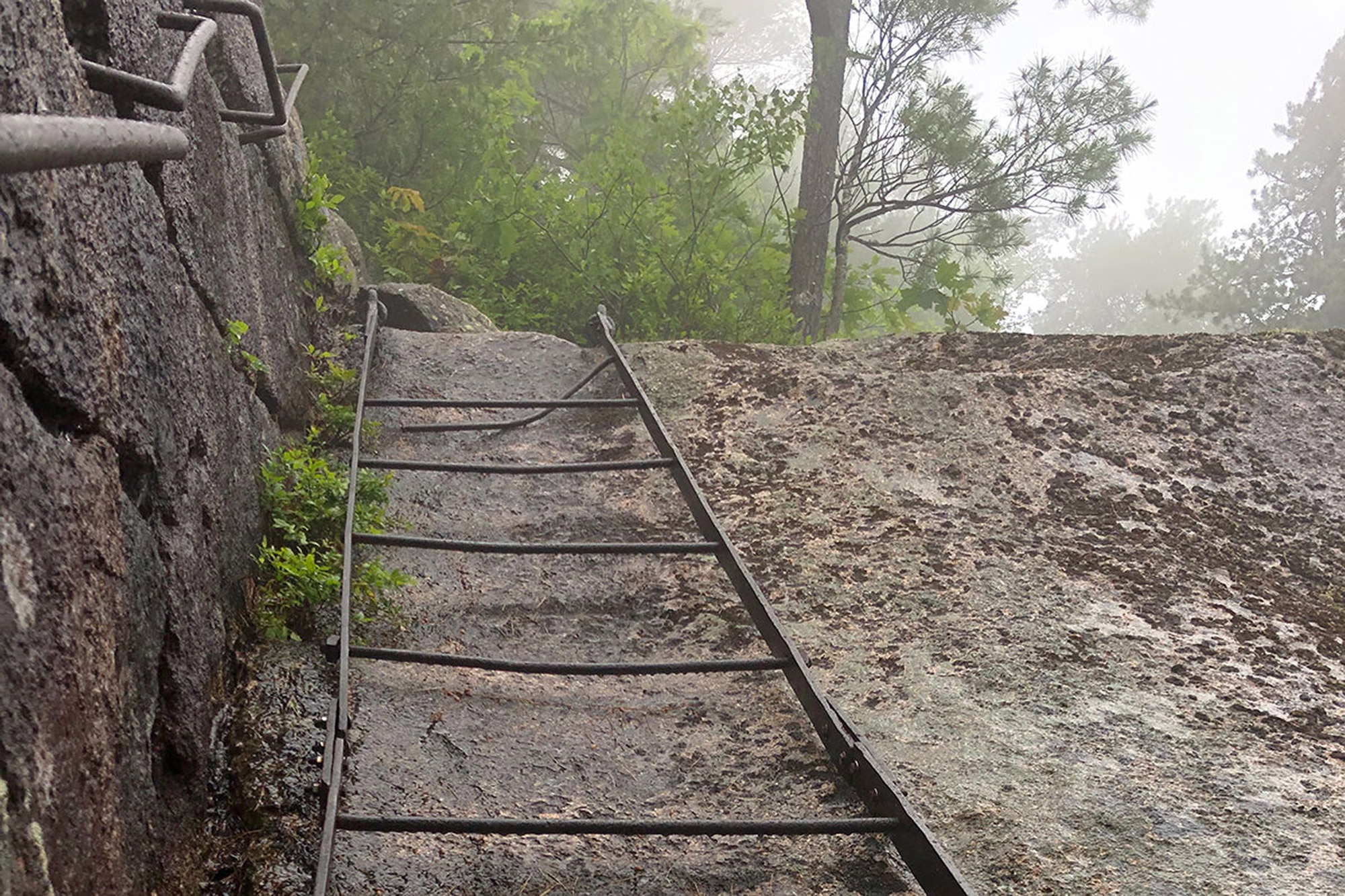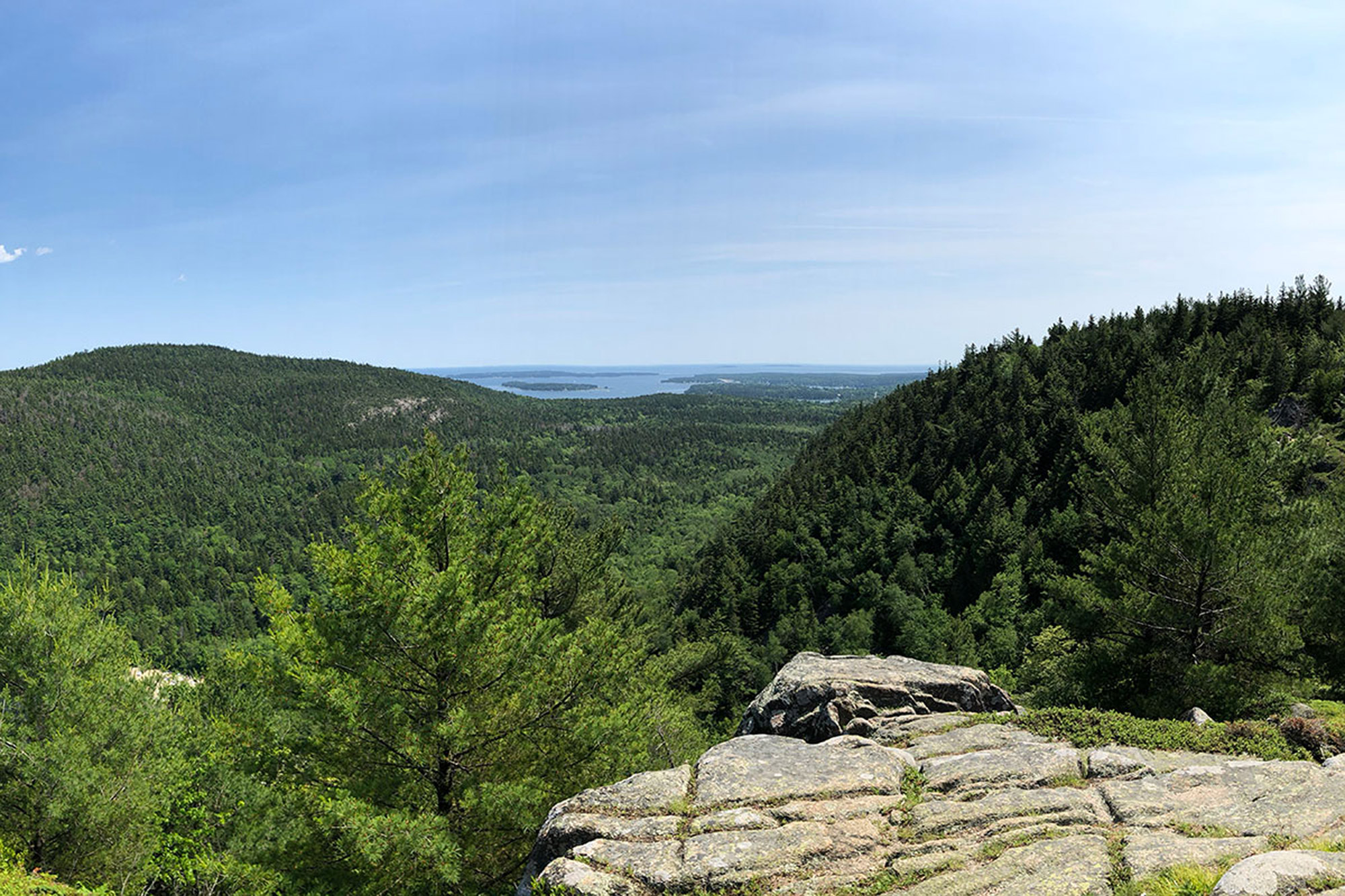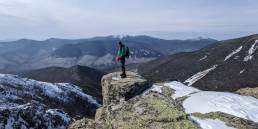Acadia National Park is known far and wide for its dramatic natural beauty, the vivid contrast of mountain and sea creating a dreamscape of bald ridgelines, sweeping ocean views, and granite cliffs that dive straight into the tide. In the spaces between, dense woodlands and immaculate waterways offer no relief from the splendor. It’s paradise, in a complete, uncompromising, and distinctly New England way.
For all Acadia’s given natural qualities, however, it’s a man-made characteristic that allows visitors the privilege of access: the trails. Miles and miles of hewn stone steps, graded carriage roads, and blazed footpaths represent a mammoth feat of ingenuity, engineering, and labor worthy of the land for which they were constructed. Among these built features, it’s the use of iron—as rungs, railings, and ladders—that stands out. Their presence, on steep, severe, and exposed terrain afford hikers access to parts of the mountains that they wouldn’t be able to achieve without technical climbing acumen—and because of their concentration in the park, they’ve become almost synonymous with Acadia. In guidebooks and online, the Park Service has even appended their rating system to include easy, moderate, strenuous, and ladder.
A word of warning, some of these trails are steep and should absolutely not be attempted by hikers who aren’t comfortable with heights.
Editor’s Note: Some of these trails, including the Precipice, Jordan Cliffs, and Beech Cliff Trails are subject to seasonal closures to protect the peregrine falcons who nest in the cliffs. These can last from mid-March to mid-August but visit the park’s website to be sure.
The Precipice
Nowhere in Acadia are those elements that define the merit of the ladder trail more apparent than on the Precipice Trail. This notoriously steep and exposed route up Champlain Mountain’s rugged eastern face follows a system of near-vertical cliffs, navigating their natural cracks and ledges with the aid of dozens of iron rungs and railings. It’s not long before substantial easterly views of the Atlantic Ocean open up and the exposure becomes palpable—in places it feels closer to a climb than a hike. In a little less than a mile—with an ascent of over a thousand feet—the Precipice gains the 1058-foot summit of Champlain, with an outstanding view of Dorr Mountain to the west as a reward. From here, link up with the Champlain North Ridge and Orange and Black Trails for 2.1 miles of what is widely referred to as the park’s premier hike.

The Beehive
Though the summit is a mere 520 feet above sea level, a quick jaunt up the super popular Beehive is a must-do on just about everyone’s Acadia list—and justifiably so. The eponymous Beehive Trail, with its iron rungs and railings, delivers sweeping views in short order by running right up its exposed southern face. From nearby Sand Beach, the crowds look more like ants marching up an anthill than bees working about their hive, but don’t let the crowds dissuade you—between the panorama and the fun of the brief, steep ladder sections, the Beehive is essential Acadia. String it together with the Bowl for a 1.4-mile loop. Getting there early and getting a spot at the beach for some post-hike chill is highly recommended.

Dorr Mountain
At 1,270 feet, Dorr Mountain is Acadia’s third-highest peak and an ascent of its rugged eastern face rewards hikers with substantial views in every direction, taking in the town of Bar Harbor to the north, Champlain Mountain to the east, the Atlantic Ocean to the south, and Cadillac Mountain directly to the west. Naturally, these views are best achieved via the aptly-named Ladder Trail. Starting just south of the Tarn, the Ladder Trail gets right to work, climbing steeply over seemingly innumerable stone steps before the first iron rungs come into view. The proper ladder section is brief but memorable, with intermittent views of Champlain through the trees. Continue up the Schiff Path over gorgeous slabs dotted with pitch pine to Dorr’s summit to take it all in. Connecting with the Dorr Mountain South Ridge and Cannon Brook Trails makes for a very pleasant 3.2-mile loop.
Jordan Cliffs
While most of the ladder trails in Acadia are designed to get hikers up a cliff face, the Jordan Cliffs Trail is actually a traverse, running north to south along a series of east-facing cliffs, between Penobscot Mountain and Jordan Pond. Although by heading north, hikers will get a cumulative elevation gain, the Traverse aspect of the Jordan Cliffs Trail promises plenty of up and down over its course utilizing wooden staircases and—naturally—iron rungs in the process. Some exposed sections offer excellent views, with Jordan Pond and Pemetic Mountain in the east, and the Bubbles, a set of postcard-worthy twin peaks on the north end of the pond. Make it a 4.6-mile loop and take in Sargent and Penobscot Mountains, Acadia’s second- and fifth-highest mountains by connecting the Jordan Cliffs Trail with the Sargent East Cliffs, Sargent South Ridge, Penobscot Mountain, and Spring Trails. The exposed ridge walk over Sargent and Penobscot is some of the best hiking in the park.

Beech Cliff
On the western side of the island—commonly referred to as the “Quietside” for it’s relative distance from the bustle of Acadia’s better known attractions—one can get their ladder fix on the Beech Cliff Trail. This short trail rises straight up through the dense woods around Echo Lake over some cut stone steps before reaching a series of four iron ladders that negotiate the shelves and ledges of a near-vertical cliff system before topping out at a junction with the Canada Cliff Trail and a beautiful view back over Echo Lake. Continue to the right to the high point of Beech Cliff and more views of the lake and out to the Atlantic in the South. This is an awesome trail to do as part of a beach day at Echo Lake—Acadia’s only swimmable fresh-water lake—or as an escape from the crowds in high summer. Do it with the Beech Cliff Loop Trail and descend via the Canada Cliff Trail for a nice little 2-mile loop.
John Lepak
John Lepak is an art director, graphic designer, and weekend mountaineer. He hasn’t met a rock scramble he didn’t like, and spends his free time either in the mountains or obsessively cooking Mexican food. When John isn’t pushing pixels, crushing miles, or making the best carnitas caseras you’ve ever tasted, you can find him living the dream in the Connecticut woods with his family. Follow him at @jhlepak.
Related Posts
April 12, 2024
Explore Like a Local: The Outdoor Mecca of North Conway, NH
There's a lot to love about this New…
April 3, 2024
5 Things To Do in the Boston Area During Mud Season
Adventure opportunities are abundant…
1 Comment
Comments are closed.





[…] hikers a sweeping view of Frenchman Bay, Schoodic Peninsula, and the Atlantic Ocean. It’s also a ladder trail, using a strategically-placed—and extremely fun—combination of iron rungs, railings, and […]